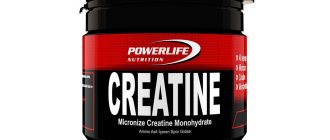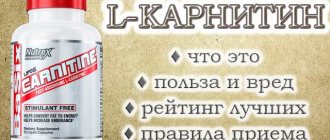Creatine is an amino acid that accumulates energy in an athlete's muscles, and also increases his overall endurance through the accumulation of adenosine triphosphate (ATP). One of the good “side effects” was water retention, which is why bodybuilders love creatine so much. The body can produce small amounts of it, but most of the amino acid is obtained from food. The richest source of this supplement is red meat.
Compound
Creatine is a compound of three essential amino acids produced in small quantities by the abdominal organs. Arginine, glycine and methionine are produced in the adrenal glands, liver and pancreas. These amino acids are extremely important and beneficial for the athlete, they contribute to:
- stimulation of growth hormone formation;
- tissue regeneration;
- increased spermatogenesis;
- participate in the formation of bone tissue and tendons;
- participate in the formation of nucleic acids;
- suppress catabolic processes;
- promote the synthesis of DNA and RNA.
It is this combination of three amino acids that is one of the best for stimulating protein metabolism.
Types and features
The most popular and in demand creatine remains monohydrate. Its main advantage is considered to be quick and easy absorption. The monohydrate is absorbed by the intestinal walls and instantly enters the blood and then into the muscles.
But there are frequent cases of side effects such as diarrhea, since monohydrate is taken on an empty stomach, it can irritate the intestinal walls.
Monohydrate should be taken in the morning before meals or half an hour before training with a sufficient amount of water. Glucose helps absorb monohydrate, so creatine monohydrate is diluted with juice. Grape juice is best for this purpose due to its high glycemic index.
One of the inconveniences of using monohydrate was the loading phase. The first week you have to take the supplement four times a day, and the following days in the morning and before training.
Important! Monohydrate must be taken in courses no longer than two months. The intake is divided into courses, due to the body’s adaptation to the amino acid.
The second option was creatine phosphate (HCL). This product turned out to be not so popular and its cost is much higher, due to more difficult obtaining. It is considered a purer product, and one of the main advantages of this variety is its ease of administration. It is taken in the morning every day. There is an opinion that it is enough to take creatine phosphate only on training days, but in practice this method has not been effective.
Note! The sports supplement does not have the side effects of monohydrate and can be taken continuously, but the drug does not cause water retention.
Perhaps due to the lack of this side effect, creatine phosphate has not become as popular as monohydrate. The dosage is 3 grams per day.
There are other types on the sports nutrition market:
- Creatine malate ethyl ester;
- Creatine ethyl acetate;
- Alpha ketoglutarate;
- Tricreatine malate;
- Dicreatine malate;
- Neoton.
All these supplements are the same creatine monohydrate with the addition of various organic acids, which provide accelerated energy release. Otherwise, the effect of all types remains the same. Also, there are also options with amino acids, but this is more of a marketing ploy, rather than an improved product.
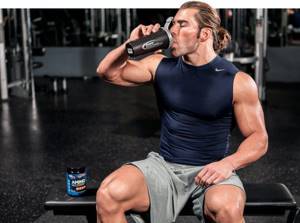
Reason why it must be taken separately
From all of the above, there follows the main reason why creatine (in any of its chemical forms) is more profitable to take as a sports supplement. Everything is very simple. With negligible presence in food and minimal synthesis from other amino acids, the average person's need for creatine is about 6-8 grams per day.
As for athletes, their need reaches a phenomenal 30 g per day. And this is not counting the fact that muscles are capable of storing creatine phosphate in amounts of up to 450 g. To organize such a supply of creatine to the body, it is necessary to consume tens of kilograms of meat per day, which will lead to rapid failure of the gastrointestinal tract. At the same time, creatine in the form of supplements has almost no interaction with the digestive system and penetrates directly into muscle tissue.
Why is creatine needed in sports?
It provides explosive strength, endurance, and energy recovery, so it is suitable for athletes of almost any sport. The supplement is most used by athletes in strength sports, such as bodybuilding, weightlifting and powerlifting.
Creatine is also used by athletes involved in martial arts and athletics. The additive works great where explosive power is needed. The effect may not be as noticeable if the athlete initially has high levels of the amino acid. This is why you can find negative reviews on the Internet that this is a useless supplement. The amino acid is not a potent substance, such as hormonal drugs, and has an auxiliary effect.
Increased strength
The supplement helps increase strength by retaining water in muscle fibers, which promotes better muscle contraction, making it possible to lift more weight and withstand greater loads. The accumulation of adenosine triphosphate helps increase explosive power, which is necessary for weightlifters or sprinters, as well as boxers to carry out explosive attacks.

Increased muscle mass
Creatine is a sports supplement that increases mass, but by itself it does not provide an increase in muscle mass, but only promotes its growth. Often, the mass gained by athletes taking creatine is simply the accumulated water in the muscle fibers. She quickly goes away when she stops taking it. In fact, muscle mass increases only through proper training and a balanced diet, divided into a large number of servings. The athlete must pay great attention to these basic factors.
Muscle quality
Creatine has absolutely no effect on muscle quality. With the exception of retaining a small amount of water, which gives a quick but insignificant increase in muscle mass. If we talk about the competitive quality of a bodybuilder’s muscles, then the supplement does not play any role here.
Creatine for cutting
It should not be used at the preparatory stage for competitions, since the additive can retain water that accumulates between muscle fibers. Also, it is not advisable for people whose workouts are aimed at losing weight.
Increased secretion of anabolic hormones
The three constituent amino acids that make up creatine affect the production of growth hormone and have a positive effect on protein metabolism and spermatogenesis.
Lactic acid buffer
Creatine promotes the elimination of lactic acid, which promotes rapid recovery after training, reduces pain and minimizes the process of glycolysis. This is why you take creatine after a workout. But this regimen is not common.
Effects of creatine on the body
The main effect of creatine when it enters the body is the accumulation of the compound in the muscles.
Other positive effects of taking amino acids:
- Increasing the transport properties of cholesterol in the body. This concerns increasing the period of removal of bad cholesterol and transportation of good cholesterol.
- Creation of lactic acid buffer. Lactic acid is the main cause of micro-tears in muscles, therefore, it acts as a direct precursor to the principle of super-recovery of the body.
- Increased oxygen transport to type 2 muscle groups (with white fibers).
- Retention and binding of fluid in the body.
These are just the general effects of creatine that affect an untrained person. Read more about the benefits and harms of creatine here.
Creatine for girls
The supplement affects the female body in the same way as it does the male body, but for women who do not engage in male sports, it is absolutely not needed. The female body reacts more strongly to the effects of creatine and properties such as water retention may be more pronounced. Creatine is especially useless for girls competing in the bikini category, because in this category the athlete must have light physical shape, lean, defined muscles, which is impossible when using this supplement.

Rules
It is also worth remembering a few rules:
- Even with the smallest portion, it is necessary that at least 300 ml of water enter the body.
- It is imperative to take a break between doses every two months, as the muscles will quickly get used to the additional proteins and will no longer perceive them as they should.
- In no case should you take creatine before training, as this slows down the process of fat breakdown and disrupts the water-salt balance in the body.
- The best time to take it is after a workout for quick absorption.
- On days when there is no exercise, creatine should be taken in the morning, immediately after waking up.
- The best day to take the drug is the day of the carbohydrate window.
- It should be used with caution by people prone to food intolerance and those with chronic diseases.
Therefore, before taking it, you need to check for the presence of the above factors. In general, creatine is considered one of the safest food additives among all others, since it does not contain any unnecessary harmful components with serious side effects.
What products contain
The best sources of creatine are red or game meat and fish. The highest content was found in cod and herring. Even cranberries contain some creatine, although the amount of the amino acid is negligible - only 0.2 grams per kilogram.
In addition to beef, there are many foods that contain the constituent amino acids arginine, glycine and methionine, and can be obtained from wheatgrass, oats, eggs and dairy products.
To obtain the required amount of creatine, an athlete must take an additional portion from sports nutrition. If your body experiences regular stress and is pushed to its limit, whether in the gym or on the football field, taking a supplement is a must and no diet will replenish the required amount in your muscles like a serving from a jar.

For opponents of sports nutrition
The main reason for the popularity and effectiveness of creatine is due to two things:
- Its low content in food products.
- Low bioavailability in food.
However, for those who still prefer to receive all the necessary amino acids and substances without sports nutrition, we have provided a table of products containing creatine phosphate.
| Amount of creatine monohydrate in food (grams per kilogram of pure product) | ||
| Product | Creatine (g/kg) | Percentage of daily dose for an athlete |
| Herring | 8 | 26% |
| Pork | 5 | 16.5% |
| Beef | 4,5 | 15% |
| Salmon | 4,5 | 15% |
| Milk | 0,1 | 0.30% |
| Vegetables fruits | <0.01 | 0.01% |
| Nuts | <0.01 | 0.01% |
As you can see from the table, in order to get an acceptable dose of creatine phosphate for training, you need to eat at least 4 kilograms of herring. During heat treatment (i.e. cooking), phosphates, which are extremely unstable to temperature, disintegrate. As a result, fried or boiled herring contains 4 times less nutrients. In other words, you will need tens of kilograms of herring per day. And consuming such an amount of food per day will easily “ruin” the athlete’s digestive system.
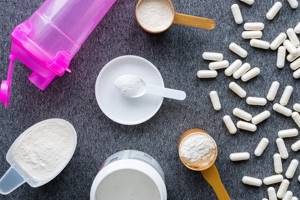
© itakdaleev — stock.adobe.com
Who needs
Creatine is great for athletes of any sport and any level of training. With the exception of those athletes who need relief and lean muscle mass. Especially suitable for powerlifting, weightlifting and bodybuilding during the period of mass gain.
It can be taken immediately from the first workout, with any level of training and even without training, as a dietary supplement if a person’s diet does not replenish the required amount of amino acids. But you may not feel the effect of taking it.
Another case is when you have reached a development “plateau”. It happens to everyone, and an athlete can experience this period repeatedly. It is at this time that the very moment comes when it is best to push your body to grow with sports nutrition, and the effects will be very noticeable. When the stagnation of results moves forward, you will begin to progress again.
Top phosphate additives
Creatine is produced by almost all well-known manufacturers:
- Optimum nutrition.
- Ultra nutrition.
- Biotech USA, etc.
Kinds
The quality of the additive from all manufacturers is approximately at the same level. Therefore, it is better to consider creatine supplements by type:
- Creatine monohydrate. The most popular type of sports supplement. The main advantages are a high degree of purification, minimization of side effects and the ability to load with creatine faster compared to other types (you can consume up to 50 g daily, reducing the loading phase by 3-4 days).
- Creatine Phosphate. The cheapest and most effective creatine. Due to the low degree of purification, it has lower bioavailability, which is why phosphate must be taken 15-20% higher than monohydrate. But even in terms of conversion, it remains a cheaper alternative for quickly gaining muscle mass.
- Creatine with transport system. This is a system for the lazy from Weider and Optimum Nutrition. The main feature is the presence of hydrolyzed grape juice, which saves the athlete from consuming sweet tea or separate water. Makes it easier to use the drug when it is impossible to get fast carbohydrates.
- Creatine hydrochloride. Produced by Biotech. Allows you to stay in the loading phase longer and not experience problems with water retention. The actual benefits over other types of creatine have not yet been proven.
Interesting fact: creatine monohydrate is often added to the composition of the gainer. So, when talking about the effectiveness of a gainer, manufacturers often mention the number of kilograms gained while taking the dietary supplement. However, creatine bloats the muscles and floods the body with water, which prevents the actual growth of muscle and glycogen fibers from being assessed. And when you stop taking the gainer, the water goes away. This effect is similar to the effect of a course of creatine. This is why advertising campaigns for gainers often hide the presence of creatine, despite the absence of potential harm to the body. (here are details about how to take mass gainer).
Harm to health
It is believed that creatine is absolutely harmless because it is a natural substance produced by the human body. But you need to know that using the drug can affect the levels of its derivative, “creatinine”. This derivative is an important indicator of kidney function. An increase in creatinine indicates a disruption in their functioning. At one time, athletes who consumed creatine were advised to get tested for their creatinine levels.
Note! There are no contraindications for use; for this purpose, studies and tests were carried out, during which it was revealed that even extremely large doses of creatine are absolutely harmless to humans.
Pros and cons of creatine
Creatine is a completely natural and approved nutritional supplement that makes it possible to increase the energy potential of an athlete. Nowadays, the diet of athletes is rarely complete without this supplement. It helps to quickly realize achievements in sports. This substance has its positive and negative qualities.

Reviews from doctors
Creatine phosphate and monohydrate, according to doctors, are absolutely useless and do not provide any benefit to the athlete. Medical opinion is ambiguous. Most experts say that the benefit is negligible and has a temporary effect. When you stop taking it, the accumulated amount is instantly used up, and the body uses creatine obtained naturally.

Which creatine is better to choose?
The sports supplement is a white powder with small particles resembling powdered sugar. The additive has no taste or smell, sometimes tastes bitter, and comes in two forms. Encapsulated and in powder form.
Despite the abundance of companies promising certain effects from use, creatine remains just creatine, so you should not chase any specific company or price. Even the cheapest product will work no worse than a newfangled one in beautiful and expensive packaging.
Capsules are much more convenient than powder, but the crumbly form may be more convenient in cases where, in addition to creatine, an athlete must consume several types of sports nutrition at one time, the total amount of water is one and a half liters. If you take it in powder, you can pour half a liter of water into a shaker, then throw in a portion of creatine, BCAA (also in powder) and maybe even a gainer in one go.

Side effects from taking creatine
Creatine phosphate came into sports disciplines relatively recently. Only in 1996 did athletes begin to actively load up on the first samples of sports nutrition. For this reason, doctors are concerned about the risk of unknown side effects due to long-term use (more than 30 years).
In the short term, creatine is unlikely to have the following side effects:
- Increased load on the kidneys. NOT recommended for people suffering from any type of kidney failure.
- Vitamin deficiency and mineral deficiency are associated with the fact that with an increase in weight and water, minerals and vitamins are concentrated in the bound fluid. You will need to take additional multivitamins.
- Sudden cramps due to insufficient water intake.
- Discomfort in the gastrointestinal tract during the loading period associated with tissue dehydration with insufficient fluid intake.
But the most important side effect comes from the benefits of creatine. It is not recommended to use creatine in loading in the presence of heart failure. At the time of taking creatine, the force of contraction of the heart muscle increases. On the one hand, it helps fight arrhythmia and other problems, and reduces the risk of heart attack. However, when leaving the drug, the opposite trend is observed. Due to the buffering of lactic acid, the heart, under severe loads, significantly exceeds its standard pulse, which can lead to pain and even microtrauma to the heart muscle.
Note: a technique with smooth loading or no loading is quite acceptable. Since the amount of creatine in the blood decreases gradually, the heart muscle has time to adapt to new conditions.
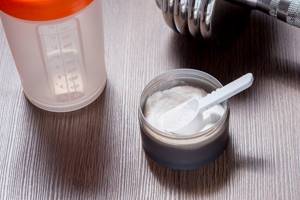
© zhekkka — stock.adobe.com
How to use
Creatine monohydrate is taken in two phases.
The first is the loading phase, it lasts a week, and during this time the amino acid accumulates in the athlete’s muscles. During the loading phase, the daily serving is 20 grams.
Take creatine in this phase in the morning on an empty stomach, at night and between meals. On training days, one of the four doses should be taken an hour before training.
The second phase is called maintenance. The daily dosage in this phase is five grams, it can be taken once a day - in the morning or before training.
On training days, it should be taken before exercise with a gainer or grape juice. This will give a big increase in strength and energy. You can also take a serving after training.
The second option for taking monohydrate is an even load, in which creatine is taken at 5 grams - in the morning or before training.
Very important! Monohydrate should be taken with plenty of water. Firstly, this will give a good pump, and secondly, it will reduce the possibility of intestinal irritation.
Combination with other products
The supplement can be combined with any sports nutrition products, with the exception of those aimed at weight loss, which will reduce the effect of taking it to “no”. These include fat burners and hormonal drugs that remove fluid and burn subcutaneous fat.
It is believed that creatine can be taken with coffee, thus reducing the accumulation of water in the muscles. Of course, this is not true. Possible if you drink too much coffee. Works very well with glutamic acid and BCAA. Ideal to shake it all up in one cocktail.
conclusions
Let's summarize. Don't be afraid of creatine. This is a great supplement, especially for strength training. It does not pose a risk to human health, is sold legally and acts quickly.
Exceeding the daily dosage will not bring you any effect. Neither positive nor negative. Excess substances will simply leave the body along with urine. Possible side effects.
You can ask me a question via feedback. I will be happy to answer! Follow the recommendations, watch your body and drink more water during your creatine cycle. Don't forget to share this article with your friends!


